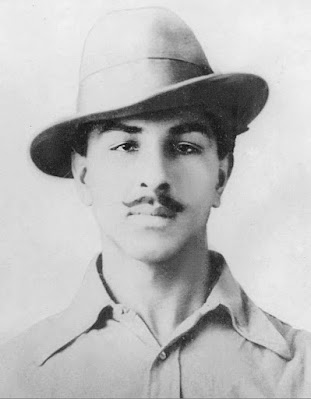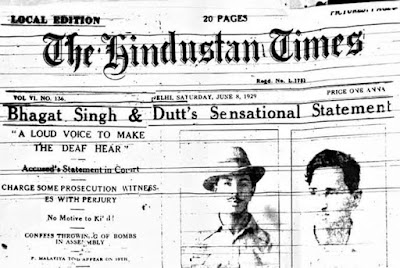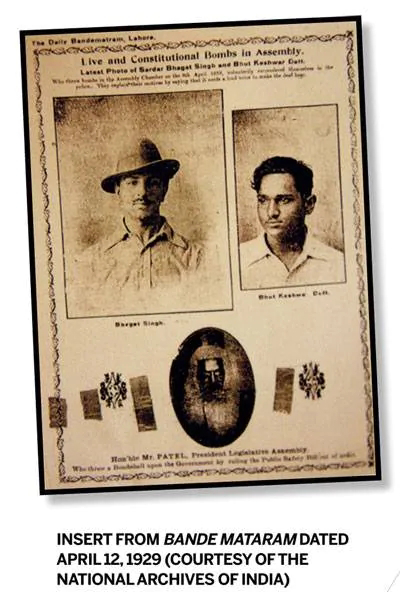Hello to all, this past week has been tormenting for me, I couldn't stay in
touch with all of my readers, missed so many important news. I also missed
quiz sets on some days. I am sorry for the same, to make things up here I am
with a midweek trivia story from the pages of the pre-independence modern
history of India. This past 28th September was the birth anniversary of the
legendary Bhagat Singh. While he has been one of the most covered freedom
fighters but there exists one unknown story related to him which has so far
eluded common knowledge.
All of us might have seen his pictures in social media handles, news, and
WhatsApp stories of our friends, some might have even noticed his portrait
hanging in walls of government buildings. Today I will be narrating the
story of this famous portrait, which is almost exclusively used with
him.

|
| Photograph of Bhagat Singh Ji |
This photo was taken in the studio of
Ramnath photographers probably on April 4, 1929, just a few
days before Bhagat Singh and Batukeshwar Dutt threw bombs in the Delhi
assembly. Ramnath Photographers was a shop in Kashmiri Gate, New Delhi.
Jaidev Kapoor, who was a member of the Hindustan Socialist Republican
Association just like Bhagat Singh which had been planning to bomb the
Assembly, arranged the photo.As British Police was searching wildly for
him and other members of the organisation, he often used to change his
identity. Bhagat Singh had renounced his kesh (the uncut hair of a Sikh)
and his turban to evade capture in September 1928, which is the reason why
he looks more like a young Indian who studied in Anglo-Indian education
system.
Kapoor specifically asked the photographer to make it a memorable saying
"our friend is going away, so we want a really good photograph of him."
indirectly pointing towards the planning of being caught after bombing
which was a sign of their protest and good intentions. Batukeshwar Dutt,
another HSRA member, was photographed on a separate occasion, but with the
same instruction.
While the photographs were being developed, Bhagat Singh and Dutt were
constantly planning and watching the movements in and around Delhi
Assembly, bombing was not done to hurt anyone and was just used as a mark
of protest, so they decided to use explosives when the president of the
house moves the bill, which happened on the morning of 8 April.
At Ramnath Photographers, however, production was delayed and
revolutionaries did not realise that Ramnath was also contracted to take
photographs for the police, and had been summoned to the police station in
Old Delhi, where Bhagat Singh was taken after his arrest on 8 April 1929,
to photograph him. It was suspected that those same pictures were used in
the early investigation of the “outrage", as the police “ransacked all the
hotels in Delhi with photographs of the accused.
Jaidev Kapoor failed to collect these photos initially, the HSRA members
wanted to collect those photographs but were scared that if they would
go to a photographer, he might hand them over to the police. Yet, it was
ultimately Jaidev who took the risk, he took a gun in his pocket and
went to collect it. The photographer gave him the pictures along with
the negatives. That was how the photograph found its place among the
masses.
The HSRA members were angry with the negative media coverage of the
action. The freedom fighters wanted to turn this coverage to their
advantage. The photographs would be pivotal to this. Sukhdev left Delhi
for Lahore, taking with him the negatives, from which he had multiple
positive photographs made.
The photo was first published by Bande Mataram, an Urdu daily published
from Lahore, on 12th April. Hindustan Times carried it on 18th April
1929. And that's how The Bhagat Singh’s hat became his defining
attribute and a lasting imagery for the hero of freedom struggle.
The article is based on the research by Kama Maclean, Professor of University of New South Wales in “A Revolutionary History of Interwar India”, a book I would highly recommend for further reading.











3 Comments
This is well written... thank you sharing this story.
ReplyDeletethank you very much for your feedback
DeleteThanks for this pieces.
ReplyDelete